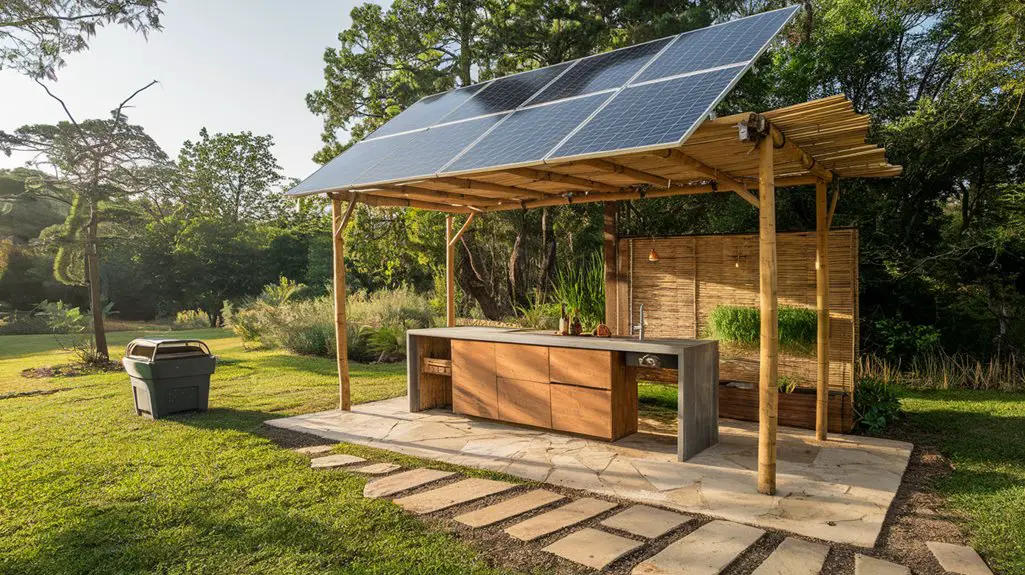If you're looking to enhance your outdoor cooking space while being mindful of the environment, a sustainable outdoor kitchen might be just what you need. By choosing eco-friendly materials and energy-efficient appliances, you can create a functional area that aligns with your values. Plus, implementing water conservation strategies can make a significant impact. Curious about the best materials and designs to get started? Let's explore the possibilities.
Choosing Sustainable Materials for Your Outdoor Kitchen
When you're designing your outdoor kitchen, choosing sustainable materials is crucial not only for the environment but also for enhancing the overall aesthetic and durability of your space.
Opt for reclaimed wood for cabinetry and countertops; it adds rustic charm while reducing waste. Consider bamboo, which grows rapidly and is incredibly strong, perfect for flooring and accents.
For countertops, recycled glass or composite materials can provide a modern look while being eco-friendly. Don't forget about eco-friendly stone options, like sandstone or granite, that require less energy to process. Additionally, using eco-friendly materials can significantly minimize your carbon footprint and promote a healthier outdoor environment.
Finally, using non-toxic sealants and finishes guarantees your outdoor kitchen remains safe for you and your guests.
Energy-Efficient Appliances for Eco-Friendly Cooking
In today's eco-conscious world, equipping your outdoor kitchen with energy-efficient appliances can considerably reduce your environmental footprint while enhancing your cooking experience.
Start by choosing ENERGY STAR-rated grills and ovens, which use less energy without sacrificing performance. Consider induction cooktops; they heat up quickly and distribute heat evenly, minimizing wasted energy. You might also explore solar-powered outdoor kitchens, harnessing renewable energy for cooking while lowering utility costs. Don't forget about energy-efficient refrigerators; they keep your ingredients fresh while consuming less power.
Finally, opt for smart appliances that allow you to monitor and control energy usage remotely. By incorporating stylish outdoor kitchens with cozy built-in seating, you'll enjoy delicious meals while contributing to a more sustainable future.
Water Conservation Strategies for Outdoor Kitchens

While you mightn't think about it, conserving water in your outdoor kitchen can significantly contribute to sustainability.
Start by installing low-flow faucets and fixtures to minimize water usage without sacrificing performance. Consider using a rain barrel to collect rainwater for watering plants or cleaning purposes. Additionally, incorporating rainwater harvesting into your outdoor water features can enhance your overall water conservation efforts.
When washing dishes, fill a basin instead of letting the water run continuously. You can also set up a gray water system to reuse water from rinsing fruits and vegetables for irrigation.
Finally, plan your cooking and cleaning to minimize water waste—organize tasks so you can use water efficiently.
Incorporating Renewable Energy Sources
As you design your outdoor kitchen, incorporating renewable energy sources can greatly enhance its sustainability and efficiency.
Start by considering solar panels to power appliances or lighting. Even a small setup can markedly reduce your energy bills and carbon footprint.
Wind turbines, if space allows, can also provide a clean energy source.
Utilizing biofuels for your grill or fire pit is another great option; they burn cleaner than traditional fuels and can be sourced sustainably.
Don't forget about energy-efficient appliances—look for those with high Energy Star ratings. Additionally, integrating rainwater harvesting into your outdoor kitchen can further promote sustainability by utilizing collected rainwater for cooking or irrigation.
Designing for Minimal Environmental Impact

To create an outdoor kitchen that minimizes environmental impact, focus on sustainable materials and efficient design.
Choose recycled or reclaimed wood for cabinetry and countertops; it's durable and reduces waste. Opt for energy-efficient appliances that consume less power, and consider using solar-powered lighting to brighten your space sustainably.
Incorporate water-saving fixtures to minimize usage, and use permeable materials for flooring to reduce runoff.
Design your kitchen layout for ideal airflow and natural light, which lowers energy needs. Additionally, consider using durable materials that withstand the elements and ensure longevity in your outdoor kitchen.
Lastly, plan for functionality by creating zones for cooking, dining, and relaxation, ensuring you maximize every square foot without unnecessary materials.
Conclusion
By investing in a sustainable outdoor kitchen, you're not just creating a beautiful space; you're also making a positive impact on the planet. Remember, "every little bit helps." From choosing eco-friendly materials and energy-efficient appliances to implementing water conservation strategies, each decision counts. Embrace renewable energy sources and design with intention to guarantee your outdoor cooking area minimizes its environmental footprint. Enjoy your culinary adventures while being a steward of the earth—it's a win-win!




